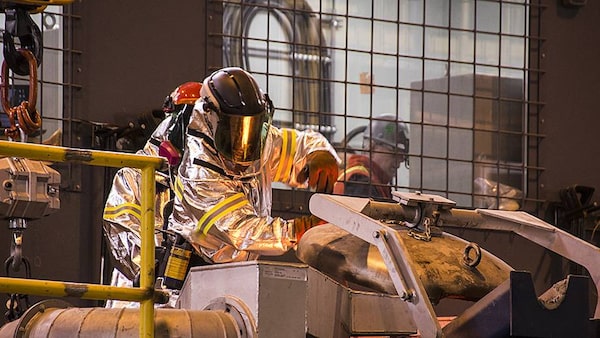
Aluminum is one of the fastest-growing commodities in the world.
The aluminum smelter in Kitimat, British Columbia was the largest in the world when it opened in 1954. Today, it's one of the greenest.
The smelter, built by the Aluminum Company of Canada, was the biggest private construction project in Canadian history in the 1950s, and the plant was a showpiece for the technology of the day – powered with clean energy from a brand-new hydroelectric plant.
Fast-forward 60 years, when the smelter, now owned by mining giant Rio Tinto, was in need of an upgrade. Rather than upgrading the original plant, the company decided once again to invest in technology that would make it a world leader – building a brand-new $6-billion smelter that uses leading-edge technology to produce some of the lowest carbon emission aluminum in the world.
"You're talking about approximately 3,500 people working on the project at the peak of construction," says Rio Tinto Aluminum Chief Executive Alf Barrios. The plant allows Rio Tinto to produce 420,000 tonnes of aluminum per year, while employing 1,000 people at one of the largest manufacturing complexes in the province.
Aluminum is produced in part through electrolysis in pots, and the new Kitimat facility has 384 of them. Barrios says, "We had to install about six million bricks in the 384 pots – that's the equivalent of building 1,100 average-size houses. We used 2,400 km of electric cables and 9,000 metric tonnes of structural steel, or nearly 1.5 times the size of the Eiffel Tower."
Expert knowledge
When asked why Rio Tinto decided to stay in B.C. rather than build elsewhere, Barrios cites a number of factors, including the hydroelectric power that allows the company to produce some of the world's greenest aluminum, and access to an ice-free port to serve North American and Asian customers in the fast-growing aluminum market. Located on the Douglas Channel, the Port of Kitimat is the third-largest on the West Coast when it comes to international trade. But one of the biggest deciding factors was local expertise. "We have more than 60 years' experience in Kitimat, which means we have a great team of people in B.C. who know and understand aluminum. They have the expertise in managing and running a smelter," Barrios says.
That expertise was essential when it came to retraining staff to run the new smelter, which opened in July 2015 and is now in its first full year producing at capacity. Barrios says, "It's one of the industry's most advanced smelting technologies. We've increased production capacity by close to 50 per cent, and at the same time increased energy efficiency by a third while cutting overall emissions in half."
Carl Anderson, President and CEO of the BC Innovation Council, says one of the things that impresses him about Rio Tinto's presence in the province is that "they're an international company who are very interested in working in British Columbia with B.C. companies."
BC Innovation Council works with companies like Rio Tinto to identify areas where they can improve through innovation, then helps connect those challenges with B.C. companies that can offer solutions. Rio Tinto, who has put an emphasis on cultivating a strong innovation sector to maximize their global competitiveness, was a natural fit to collaborate with the BC Innovation Council.
"It doesn't matter if you're a local start-up company or an established international organization, innovation can open up so many new possibilities for growth and development, says Anderson. "It's incredibly exciting to see a global company like Rio Tinto committing to finding innovative solutions and working with local talent to maximize their global competitiveness."
Innovation culture
"An important part of change is bringing in outside eyes," Anderson says. "They do a lot of research into improving their processes, but we also saw things we could help with. What if there is work someone else has done that you don't know about? Bringing together those challenges and possible solutions – that's the key stuff."
Anderson cites the example of a B.C. company that uses drones to inspect critical infrastructure.
"Rio Tinto has an 80-km power line from Kemano, where they generate electricity, and the plant in Kitimat. They need to closely inspect that infrastructure," he explains. Rio Tinto uses drones at other sites and is interested in their potential at Kitimat. Aeriosense, a top 10 finalist in the 2017 BCIC New Ventures competition, uses machine-vision technology to remotely inspect work transmission towers and power lines and BCIC knew that it could "cut inspection time from months to days." Anderson says. "This is the kind of thing we do. We go around the province connecting companies who have challenges with solutions."
Aluminum is one of the fastest-growing commodities in the world – driven in part by a sharp increase in demand from car manufacturers seeking to build lighter and more efficient vehicles. The combination of that market, sustainable production processes and the investment Rio Tinto has made in Kitimat "ensures that we will continue to operate in B.C. for decades to come," Barrios says – leaving plenty of opportunity for tomorrow's innovations.
This content was produced by The Globe and Mail's Globe Edge Content Studio, in consultation with an advertiser. The Globe's editorial department was not involved in its creation.